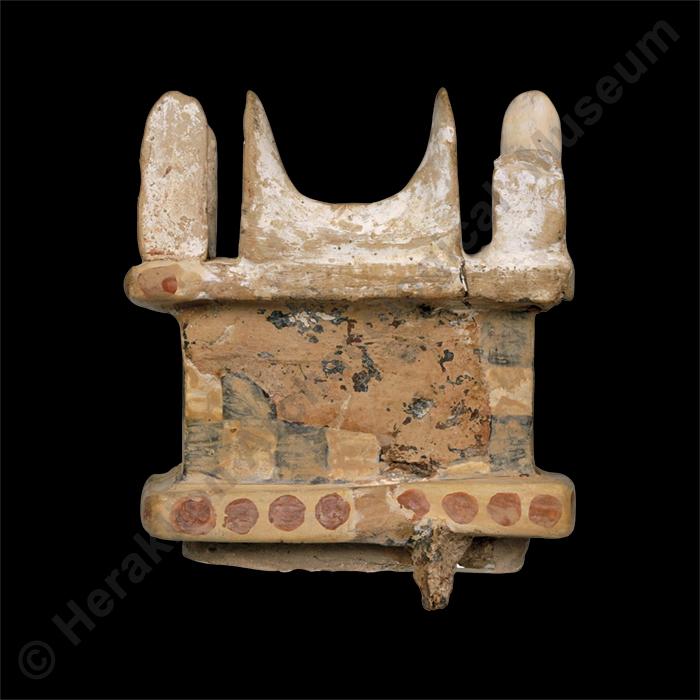Clay model of sacred building or altar
Π2584
Clay
Preserves parts of one side and the juncture of two sides, the upper cornice and the horns of consecration. The model has been restored based on other finds from the Loomweight Basement.
Length: 7.3 cm. Height: 10.3 cm.
Knossos
Palace, East Wing, Loomweight Basement
Middle Bronze Age. Neopalatial period, Middle Minoan ΙΙΒ- ΙΙΙ period:
1700-1600 BC:
Gallery:
IVCase:
37Exhibition thematic unit:
Late Bronze Age - Neopalatial period (1700-1450 BC). The New Palaces. The zenith of Minoan civilisationThe Minoan world. Architecture
Description
Clay model of an architectural structure in the shape of an open square U-shaped frame surmounted by horns of consecration. An ornamental cornice projects from the vertical wall of the structure and runs around the upper edge, under the horns, and around the base. The structure bears painted decoration of red discs on the cornices and a black-and-white chequerboard motif on the rest of the surface. An elongated lip along the bottom edge of the three sides and a triangular protrusion on one side indicate that the object was set into a base. The chequerboard motif is thought to represent coursed masonry, while the discs are interpreted as the ends of wooden beams. These structural elements of domestic and palatial architecture are seen in buildings depicted in frescoes, on seals and stone vessels, and in the unique set of painted plaques depicting house façades (the “Town Mosaic”). The horns of consecration crowning the structure bear religious symbolism, supporting the view that the model is a shrine or altar. According to another interpretation, the fact that the model was attached to a base indicates that it is part of a wider group of three-dimensional models from the Loomweight Basement, which form the background scenery for the human actions depicted.Bibliography:
A.J. Evans, The Palace of Minos: A Comparative Account of the Successive Stages of the Early Cretan Civilization as illustrated by the Discoveries at Knossos, 4 vols., London 1921-1935, I, 220-21. I. Schoep, "Home sweet Home". Some Comments on the So-called House Models from the Prehellenic Aegean, Opuscula Atheniensia XX (1994).Author:
S. M.Photographs' metadata
